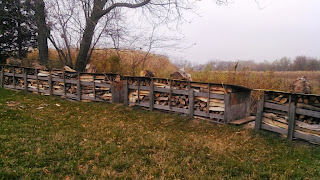I really didn’t see it coming. Then again, why would I? Yet
once it arrived there it was, plain to see and compelling: the final word of the blog Rah-dur.
Like a trickster flapping a sheet over my bed, the morning
fog lifts then returns again. His white
veil drops the photovoltaic output from 800 watts to 200 watts. The solar hot water panels, which had quickly
rose to 80F, now struggle to hold on. Still
the frost turns to dew. And buckets of
pooh call from the garage. “Dump
me! Clean me!”
Thanks to the wood-splitting heroics of my friend Chip, the
masonry heater simply shrugs, “What fog? I’m
soaking up this morning’s fire, preparing to massage you with my radiance.” The great south facing gang of windows
feel less certain of adding their sun-inspired warmth. Will the clouds arrive before the fog lifts his white sheet?
And will the rain come? If it does, if it really, really does for a
change, there’s going to be a party here at Home the Land Built. As usual, we have no idea how much water is in
our cistern. And we won’t know until it fills to overflowing. Please overflow before the long
rainwater harvest drought of winter!
All this is to say I'm blessed. I'm blessed to engage in the abundance and
scarcity of the Land. I'm blessed to
feel this heightened awareness. The
heightened awareness of real solar energy: electricity, warmth, rain, trees.
The heightened awareness of life and death and life renewed. The heightened
awareness of the great Connection.
I am Savanna the Wonder Dog, following my
nose to joy. I am tree-climbing, fort-building,
fire-lighting boy. I am Indian grass: writhing root, hopeful seed, sun-reaching leaf.
Now bowing like Indian grass I wave good-bye.
Like my novel The Corridor, I didn’t know I’d written the
last line until I wrote it. I knew the previous week's blog ended the How It Works Series. Yet when I hit the publish button my head
shot up like Bambi on alert.
I could give all kinds of reasons for saying good-bye. Yet there’s only one reason that
matters: I felt the time had come. And I trust that feeling as much I trust the
return of the sun. I’m sure I will
continue reading and responding to blog comments (and deleting the weird
ones). I’m sure I will pretty-up this blog for better
reader access. I’m sure there will be
other blogs to come. And it seems I’m
fated to write yet another novel---a young adult’s prequel to The Corridor---though
I have not yet begun to market The Corridor. Still, with one last click of the Publish button---and all the mixed emotions that come at such times---I wave good-bye to
Rah-dur.
So I say thank-you. Thank you for the gift of your attention. You have no idea, dear blog reader, how much I’ve thought of you, counted
on you each week. You were the one and
only reason for this blog. What a sun streaming, cloud bursting, life pulsing experience you gave me.
I’m a lucky man.
Rah-dur!








































